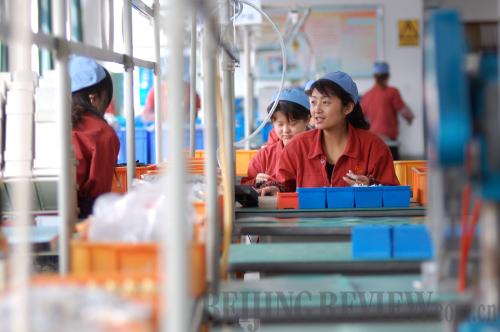|
 |
|
THE COST OF DOING BUSINESS: Workers at Tianshui 213 Electronics Co. Ltd. in Gansu Province assemble circuits. Many assembly line workers are being paid more for their skills (ZHOU WENTAO) |
The Chinese economy grew 9.6 percent year on year in the third quarter of 2010.The World Bank's Beijing Office released its latest China Quarterly Update on November 3, applauding China's economic achievement while giving some policy suggestions for future development. Edited excerpts follow:
The global economy, after a short boost, is starting to slow again.
In China, notwithstanding the surprisingly robust third quarter, growth may also lose steam in the short term and will likely affect China's exports. Some of the impact stems from the normalization of the macro policy stance, the eventual impact of the measures introduced to contain property price rises, and some administrative measures to meet energy efficiency targets. Nonetheless, we're revising our GDP growth forecast for this year to 10 percent after this stronger-than-expected quarterly growth.
Growth is likely to level off in 2011 and the next few years. But this growth, even a less robust one, should continue to be supported by the traditional growth drivers and robust macroeconomic fundamentals. In early 2011, it could be stifled if temporary measures are ceased to meet energy efficiency targets. New public investment programs are also likely to start up next year to accelerate urbanization in China's interior and promote new sectors of strategic importance. However, these are unlikely to fully offset the impact of an ending to the 4-trillion-yuan ($586-billion) stimulus package. In all, with export growth lower, but consumption benefiting from a robust labor market and private sector investment assumed to hold up, we project a moderate GDP growth of 8.7 percent next year.
For now, growth should remain robust, although potential growth is likely to diminish. There are of course risks to this outlook. On growth, the global risks, including those with respect to global imbalances and possible policy responses, are most likely to affect China. A lack of success in rebalancing China's growth pattern would also be among the more serious medium-term risks for China and the world economy. Upside risks with respect to inflation could arise from further shocks affecting raw commodity prices or from sustained wage increases driving up core inflation.
Economic policies
China's favorable growth outlook warrants further normalization of the macroeconomic stance. After the large stimulus, the key macroeconomic concerns involve asset price increases, strained local government finances, and non-performing loans. While the inflation outlook does not seem worrisome, the upward risks call for vigilance and managing inflation expectations. Notwithstanding the slack and unemployment in many high-income countries, China's economy is operating close to full capacity and the growth outlook is favorable. Thus, further consolidation of the overall macroeconomic stance is needed to contain these risks.
One of the key macroeconomic control objectives is changing the growth pattern. This adjustment—toward more services and consumption and away from the emphasis on industry and investment—will address China's social, environmental and external imbalances. Progress has been made in several specific areas, however, there has been limited progress with the overall rebalancing.
On the expenditure side, consumption has so far substantially lagged investment. But on the production side, the tertiary sector has kept pace with the secondary (largely industrial) sector, but has not grown faster, in real terms.
|
